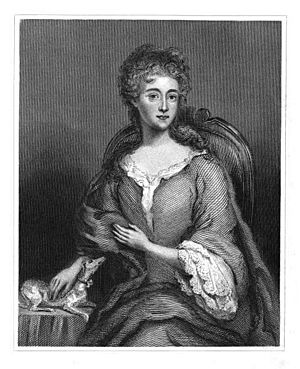Winifred Maxwell, Countess of Nithsdale facts for kids
Quick facts for kids
Winifred Maxwell
|
|
|---|---|
| Countess of Nithsdale | |
 |
|
| Tenure | 1699–1716 |
| Predecessor | Lucy Douglas |
| Successor | Title forfeited |
| Born | Winifred Herbert c. 1680 |
| Died | 1749 (aged 68–69) Rome, Italy |
| Noble family | Herbert (by birth) Maxwell (by marriage) |
| Spouse(s) | |
| Father | William Herbert, 1st Marquess of Powis |
| Mother | Lady Elizabeth Somerset |
Winifred Maxwell, also known as Lady Winifred Herbert, was born around 1680. She became the Countess of Nithsdale. She is famous for bravely helping her husband, William Maxwell, escape from the Tower of London in 1716.
Winifred's father was the first Marquess of Powis, a very important nobleman. On March 2, 1699, she married William Maxwell, the 5th Earl of Nithsdale. He was a Catholic nobleman. They met in France, where Winifred's father was living away from England. William was there to visit the former King James II.
The couple lived in Scotland at a place called Terregles. They had five children together.
Contents
A Dangerous Rebellion
In 1715, William, the Earl of Nithsdale, joined a group called the Jacobite rebellion. This group wanted to put the old royal family back on the throne. However, William was captured during a battle and sent to the Tower of London. He was found guilty of treason, which means going against the king or country. His punishment was to be put to death.
Winifred was at home in Scotland when she heard the terrible news. She quickly traveled to London to be with her husband. Part of her journey was on horseback in very cold winter weather.
Seeking a Pardon
Winifred tried to get help for her husband. She asked King George I to forgive William. But the King refused to even listen to her. When she knelt and held onto his coat, he pulled away from her.
Winifred realized there would be no pardon for William. She knew she had to come up with a clever plan to save him.
The Daring Escape
The night before William was supposed to be put to death, Winifred put her plan into action. She had help from two other ladies who supported the Jacobite cause.
Winifred was allowed to visit William in his room in the Tower. She brought her maid with her. As part of her plan, William secretly changed clothes with the maid. He put on the maid's clothes, including a special cloak that belonged to the Nithsdale family. This cloak is still kept by the family today.
Dressed as a woman, William was able to walk past the guards without them realizing who he was. He escaped from the Tower and fled to France.
Life After the Escape
After helping William escape, Winifred returned to Scotland. She made sure that their family's property would be passed on to their son. This was important so the family would not lose everything.
Later, Winifred joined William in France. From there, they traveled to Rome, Italy. They lived there as part of the group around the "Old Pretender," who was the son of the former King James II. Winifred lived about five years longer than her husband in Rome. She passed away in 1749.
In Literature
Winifred Maxwell's amazing story of helping her husband escape from the Tower of London has inspired writers. James Hogg wrote a poem about it called Ballad of the Lord Maxwell. It was first published in a magazine in 1831.

